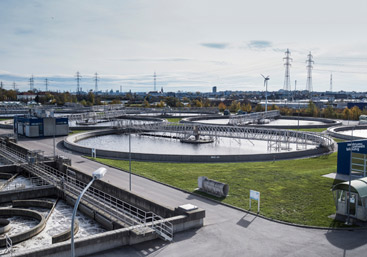SWMI – a funny acronym for serious issues
SWMI – a funny acronym for serious issues
The EU Water Framework Directive aims to make all waters cleaner and healthier. To meet these requirements, the ICPDR's Danube River Basin Management Plan takes a close look at the most important pressures affecting water status.

Investments in urban wastewater treatment plants have resulted in a remarkable decrease of organic pollution and point source nutrient emissions.
© Siemens
The Danube River Basin District Management Plan – Update 2015 identifies four significant water management issues, called SWMIs, as the main pressures of basin-wide importance affecting the ecological and chemical status of surface waters: pollution by organic substances, nutrients and hazardous substances as well as hydromorphological alterations.
Pollution by organic substances. Organic pollution refers to emissions of non-toxic organic substances that, to a large extent, can be biologically decomposed by bacteria. Organic pollution can deplete the oxygen in the aquatic environment through the biochemical decomposition of organic matter and cause health hazards from microbiological contamination of the water. The key emitters of organic pollution are localised sources such as untreated or insufficiently treated municipal wastewater from domestic, industrial or agricultural activities.
Investments in urban wastewater treatment plants with minimum biological treatment technology and enhanced industrial technologies have helped decrease organic pollution significantly. Since 2005, organic emissions via wastewater have decreased by almost 50% as a result of substantial development in wastewater infrastructure, and wastewater collection and treatment had improved at almost 900 agglomerations by 2015.
Nevertheless, not all measures have been taken and there is still room for improvement. By 2021, basic infrastructural development facilities – either public sewer systems with adequate waste water treatment or appropriate decentralised systems – will serve approximately 15 million inhabitants.

© Novum
Pollution by nutrients. Nutrient pollution is caused by excessive releases of nitrogen and phosphorus into the aquatic environment. These excess nutrients cause eutrophication, where the growth of algae or macrophytes (aquatic plants large enough to be seen by the naked eye) is substantially accelerated. This can severely impair water quality and even limit human use of water. Eutrophication is increasingly important as the Black Sea is the ultimate recipient of the Danube’s waters, and its ecosystem is particularly sensitive to excess nutrients.
Nutrient emissions originate from both point (localised) sources – similar to those of organic pollution – as well as diffuse sources such as runoff, soil erosion and subsurface flow, all of which transport nutrients from agriculture, urban areas, atmosphere and even natural areas.
As with organic pollution, the development of wastewater infrastructure has resulted in a remarkable decrease in point sources of nutrient emissions since 2005. Diffuse emissions have also dropped substantially owing to low agricultural intensity in many countries and the implementation of environment-aware agricultural measures. Compared to 2005 figures, this translates to a 12% decrease in nitrogen emissions and a 34% decline in phosphorus emissions.
However, there remains much to be done to reduce nutrient contamination. By 2021, wastewater treatment for 20 million inhabitants should be enhanced with the introduction of costlier nutrient removal technology. Fertiliser application will be strictly regulated in more than 80% of the basin, and several good agricultural practices will be in place to reduce nutrient losses.
Pollution by hazardous substances. Hazardous substances, emitted from point or diffuse sources, pose serious threats to the aquatic environment. Depending on their concentration and the environmental conditions, they can cause acute or chronic toxicity. Some hazardous substances are persistent, degrade slowly and can accumulate in the ecosystem.
Domestic wastewater, industrial facilities, urban paved areas, agriculture and chemically contaminated sites are the most important sources of hazardous substances pollution. According to scarce information available on emissions, 33 compounds have been released by major industrial facilities and wastewater treatment plants. Of these substances, eight organic pollutants, eight heavy metals, three pesticides, eleven chlorinated organic substances and three inorganic pollutants were identified.
Despite our expertise in pollution control we still face a significant information gap, and improved analyses of pollution sources and implementation of measures are high on the ICPDR agenda. Treating urban wastewater appropriately and using best available techniques in industrial plants and large agricultural holdings can significantly mitigate hazardous contaminations. Further efforts are needed to identify priority substances and other emerging chemicals of basin-wide relevance. In particular, pollution sources should be investigated using emission inventories and regionalised pathway modelling.
Hydromorphological alterations. Anthropogenic, or man-made, pressures resulting from engineering measures for flood protection, hydropower generation or inland navigation can significantly alter the natural structure and dynamics of surface waters. River continuity interruptions, morphology alterations, disconnected wetlands and hydrological alterations such as impoundments, water abstractions and hydropeaking can all affect the ecological status of the river and its ability to provide adequate habitats and conditions for aquatic species.
A number of measures have been taken since 2009 to improve hydromorphological conditions: More than 120 fish migration aids have been built, over 50,000 ha of wetlands reconnected and improved, and more than 50 measures addressing hydrological alterations have been implemented.
Efforts to further improve hydromorphological conditions by 2021 are being planned, including installing 146 additional fish migration aids, morphology restoration measures for 77 water bodies and reconnection and improvement of some 15,000 ha of wetlands. In 66 cases, measures are foreseen to reduce the impacts of impoundments, water abstractions and hydropeaking.
Further pressures imposed by new infrastructure projects should be carefully avoided. A total of 39 infrastructure projects have been planned by 2021 related to navigation, flood protection, hydropower generation and water supply, and the ICPDR is working intensely on targeted inter-sectoral cooperation activities to ensure the sustainability of such projects.
Adam Kovacs is the Technical Expert on Pollution Control in the ICPDR Secretariat.






